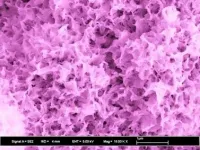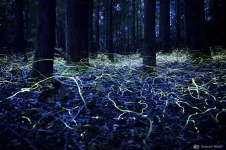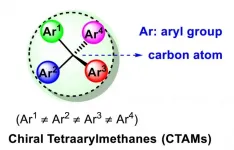Lehigh U. researchers: 'One step closer to unlocking mysteries of the bio/nano interface'
Proteins choreograph the infinitesimal dance of living cells and functional biomaterials
2021-03-11
(Press-News.org) An interdisciplinary research team at Lehigh University has unraveled how functional biomaterials rely upon an interfacial protein layer to transmit signals to living cells concerning their adhesion, proliferation and overall development.
According to an article published today in Scientific Reports, the nanoscale features and properties of an underlying substrate do not impact the biological response of cells directly. However, these properties indirectly influence cell behavior through their control over adsorbed proteins.
In the article, "Nanostructure of bioactive glass affects bone cell attachment via protein restructuring upon adsorption," the Lehigh team demonstrates that living cells respond to interfacial layer characteristics that arise as a consequence of micro- and nano-scale structures engineered into a substrate material. These infinitesimally-tiny structures have an enormous impact upon the nature of the proteins and how they restructure themselves and electrostatically interact with the material, which in turn influences the manner in which cells attach to the substrate and develop over time.
"There are others who have studied the interfacial protein layer," says Himanshu Jain, the T.L. Diamond Distinguished Chair in Engineering and Applied Science and Professor of Materials Science and Engineering at Lehigh, who also serves as director of Lehigh's Institute for Functional Materials and Devices (I-FMD). "But this work showed directly and unambiguously for the first time how some specific nanoscale features of the substrate can impact the secondary molecular structure of the proteinated interface that in turn affects the response of the cells that are thousands of times larger."
Joining Professor Jain in guiding this research is Matthias Falk, a Professor of Cell Biology with Lehigh's College of Arts and Sciences. The team is rounded out by two doctoral students jointly supervised by Falk and Jain--Dr. Tia Kowal, who received PhD in Biological Sciences and is now a postdoctoral researcher at Stanford Medicine, and lead author Dr. Ukrit Thamma, who completed his doctorate in Materials Science and Engineering and is now a lecturer at King Mongkut's University of Technology in Bangkok, Thailand.
"Lehigh is increasingly recognized as a place where interdisciplinary team science is taking root and flourishing," says Jain. "The creation and mission of Lehigh's Interdisciplinary Research Institutes is a strategic expression of this notion--and this project is an expression of that notion in action. And the crucial role that our students play, with support from a broad faculty team, speaks for itself."
INFORMATION:
To learn more about the research, please review the March 11 article "Nanostructure of bioactive glass affects bone cell attachment via protein restructuring upon adsorption" in Scientific Reports.
About Professor Jain
Dr. Jain's research activities include functionality in glass through fundamentals. He serves as the T.L. Diamond Distinguished Chair in Engineering and Applied Science, Professor of Materials Science and Engineering, and Director of Institute for Functional Materials and Devices (I-FMD) at Lehigh University. An author of 12 patents and nearly 400 research publications, he is the editor or author of ten books or special journal issues on glass science and technology. Over the past three decades he has focused on introducing new functionality and novel processing of glass through fundamentals, and making glass education available worldwide freely. In recent years, he has been developing a student-centered model of doctoral education in STEM fields, which focuses on use-inspired research through industry-university partnership.
About Professor Falk
Matthias Falk, PhD, is Professor for Cell Biology in the Department of Biological Sciences at Lehigh University, Bethlehem, Pennsylvania, USA. Dr. Falk studied biology in Germany and received his PhD from the University of Heidelberg. In 1992 he joined the Scripps Research Institute (TSRI) in La Jolla, California, as a postdoctoral researcher, and was appointed to its faculty in 1998. He joined Lehigh University in August 2003. Dr. Falk's research investigates the biosynthesis, structure and function of gap junctions, plasma membrane channels that provide direct cell-to-cell communication and physical cell-cell adhesion. He teaches classes and lab courses in Molecular Cell Biology on all levels. He also tests the biocompatibility and bioactivity of dual-porous glass bioscaffolds for hard tissue regeneration that were invented at NSF's International Materials Institute for New Functionality in Glass (IMI-NFG) at Lehigh University. Dr. Falk has published over 70 manuscripts in international peer-reviewed journals, has attracted extensive extramural funding including the National Institutes of Health (NIH), and has contributed significantly to our understanding of gap junction function in physio-/pathology.
Key Links:
--Faculty profile: Himanshu Jain, Lehigh University
--Faculty profile: Matthias Falk, Lehigh University
--Researcher profile: Tia Kowal, Stanford Medicine
--Researcher profile: Ukrit Thamma, King Mongkut's University of Technology
--Department of Materials Science and Engineering, Lehigh University
--Department of Biological Sciences, Lehigh University
--Institute for Functional Materials and Devices, Lehigh University
[Attachments] See images for this press release:

ELSE PRESS RELEASES FROM THIS DATE:
2021-03-11
Firefly beetles rank among the world's most charismatic creatures, with luminous courtship displays that have now turned them into a popular attraction for wildlife tourists. In the first comprehensive review of firefly tourism, published in the journal Conservation Science and Practice, an international team of biologists led by a Tufts University researcher, reveal that an estimated 1 million people now travel each year to witness bioluminescent performances starring some two dozen firefly species around the world.
But the authors also point out that while this unique, insect-based tourism ...
2021-03-11
An eight-week programme of mindfulness meditation improves quality of life and reduces fear of activity in heart attack patients, according to research presented today at ESC Acute CardioVascular Care 2021, an online scientific congress of the European Society of Cardiology (ESC).1
"A heart attack is a serious life-threatening event and survivors can suffer from low quality of life," said study author Dr. Canan Karadas of Hacettepe University, Ankara, Turkey. "One reason is a fear of movement, called kinesiophobia, which limits daily activity due to concerns of another heart attack."
"Mindfulness refers to the mental state achieved by focusing awareness on the present moment, ...
2021-03-11
The research was published on the journal Nature Catalysis on December 14, 2020.
A strong bias towards linear and disc-shaped molecules has long been observed in drug molecules. In contrast, spherical molecules have been utilized on far fewer occasions, due to the lack of efficient access to the latter chemical space. Specifically, efficient strategies to synthesize tetraarylmethanes, a unique family of spherical molecules, have remained scarce.
Chiral tetraarylmethanes (CTAMs), a unique family of spherical molecules which bear four different aryl groups with defined stereochemistry, remain as a mystery due to the lack of efficient asymmetric synthesis. The challenge in asymmetric synthesis of CTAMs lies in not only the high barrier in making ...
2021-03-11
Giving at scale by the super-wealthy has done little to redistribute wealth from rich to poor, helping perpetuate social inequalities rather than remedying them, while paying considerable dividends to donors in the form of privilege and influence in society and politics, new research shows.
In the research paper 'Elite philanthropy in the United States and the United Kingdom in the new age of inequalities' researchers at the University of Bath School of Management and Newcastle University Business School also conclude that giving by the super-wealthy has failed significantly to benefit poor countries in the developing ...
2021-03-11
Pregnant women remain at increased risk of severe COVID-19, and their risk of being admitted to intensive care or needing invasive ventilation is higher than non-pregnant reproductive aged women with the virus, an ongoing global study has found.
Pregnant women with COVID-19 are at increased risk of severe COVID-19, particularly if they are from ethnic minority backgrounds, or if they have pre-existing conditions like obesity, high blood pressure and diabetes, concludes the research led by the University of Birmingham and World Health Organization (WHO).
Their research, ...
2021-03-11
New research indicates that lockdowns to help tackle the spread of COVID-19 could be linked to an increase in symptoms associated with eating disorders.
The longitudinal study, carried out by academics from Anglia Ruskin University (ARU) in Cambridge, England, and published in the journal Psychiatry Research, examined the behaviour and attitudes of 319 health club members during the summer of 2020.
The researchers followed up initial research into addictive or unhealthy behaviours, conducted in 2019, to investigate the effects of the first COVID-19 restrictions introduced in the spring of 2020.
Participants, with an average age of 37, completed the eating attitudes test, called EAT-26, which involved answering questions related to statements ...
2021-03-11
Osteosarcoma is a painful and aggressive bone tumour in dogs that is known to be more common in certain breeds than others. New research has now confirmed that larger breeds, such as Rottweiler, Great Dane and Rhodesian Ridgeback, have a greater risk of osteosarcoma than smaller breeds, as well as showing that breeds with shorter skulls and legs have lower osteosarcoma risk. The findings could inform future breed health reforms as well as studies into the way tumours develop from normal bone.
The study led by the University of Bristol Veterinary School in collaboration with Cardiff University and Royal Veterinary College (RVC) London, and using data from VetCompass™ and Veterinary Pathology Group (VPG) histology, looked at the epidemiology surrounding which dog breeds ...
2021-03-11
Women of the ruling class may have played an important role in the governance of El Argar, a society which flourished in the southeast of the Iberian Peninsula between 2200 and 1550 BCE, and which in the last two centuries of its existence, developed into the first state organisation of the western Mediterranean.
These are the conclusions reached by researchers from the Universitat Autònoma de Barcelona (UAB) who led a study analysing the contents of a princely tomb (Grave 38), containing two individuals and a large amount of valuable items. The tomb was discovered in 2014 at the archaeological site of La Almoloya in Pliego, Murcia, beneath what was later identified to be the governing hall of a palatial building.
"La Almoloya ...
2021-03-11
Almost 60% of frontline health and social care workers (HSCWs) experienced a mental health disorder during the first COVID-19 lockdown, with many suffering "very high rates of distress", suggests a new study led by researchers at UCL and the University of Haifa, Israel.
Given the significantly high levels of mental health disorders across all HSCWs, the researchers (part of the UCL-led COVID Trauma Response Working Group*), are now calling for long-term planning to meet the needs of staff from across health and social care, including specialist trauma services to be set up for healthcare workers, similar to the specialist commissioned NHS psychological trauma services for military veterans.
The 'Frontline-COVID study', published ...
2021-03-11
Stormier weather will increasingly force fishers to choose between their safety and income, researchers say.
Climate change is causing more extreme weather in many locations. Storms will likely increase around the UK in the future, while many fishers in the UK also face economic insecurity.
The new study - led by the University of Exeter - worked with fishers in Cornwall to understand how they balance the risks and rewards of fishing in varying conditions.
Factors that made skippers more likely to risk fishing in high wind or waves included: being the main earner in their household, poor recent fishing success, and having a crew to support.
"Climate ...
LAST 30 PRESS RELEASES:
[Press-News.org] Lehigh U. researchers: 'One step closer to unlocking mysteries of the bio/nano interface'
Proteins choreograph the infinitesimal dance of living cells and functional biomaterials




